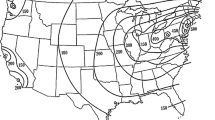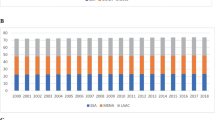Abstract
The research streams of transition economies and emerging markets have some common ground, but yet differ. The goal of this study is to provide a better understanding of the commonalities and differences regarding trends and topics of this cross-disciplinary research area. We employ the novel method of topic models on a corpus of nearly 6,000 articles in more than 600 journals from 1995 to 2012 to identify 25 topics and analyze their trends and use across scope (transition or emerging), disciplines (business or economics) and geography (countries or regions).




Similar content being viewed by others
Notes
More precisely, the latter term dates back to the early 1980s. We discuss this in detail later.
For the rest of this paper we will use the combined term transition markets to refer to this joint research area.
See, for example, Popov (2007).
The potential fourth issue of sensitivity of results on various similarity measures is not critical (An and Wu 2011).
The placement on the map is quite similar with the choice of the other scope or discipline as well as the difference of scores for scope and discipline.
With a cutoff point further up in the hierarchical tree Colombia can be also included in the emerging countries cluster.
References
An, X., & Wu, Q. (2011). Co-word analysis of the trends in stem cells field based on subject heading weighting. Scientometrics, 88(1), 133–144.
Azerbaijani Presidential Administration. (2012). Azerbaijan 2020: Look into the future. http://www.presidentaz/files/future-enpdf.
Blei, D. M. (2012). Probabilistic topic models. Communications of the ACM, 55(4), 7784.
Blei, D. M., & Lafferty, J. D. (2006). Dynamic topic models. In Proceedings of the 23rd international conference on machine learning.
Blei, D. M., & Lafferty, J. D. (2007a). A correlated topic model of science. The Annals of Applied Statistics, 1(1), 17–35.
Blei, D. M., & Lafferty, J. D. (2007b). Topic Models. In A. Srivastava and M. Sahami (Ed.), Text Mining: Classification, Clustering, and Applications . Chapman & Hall/CRC Data Mining and Knowledge Discovery Series.
Blei, D. M., Ng, A. Y., Jordan, M. I., & Lafferty, J. (2003). Latent Dirichlet allocation. Journal of Machine Learning Research, 3(4/5), 993–1022.
Buckley, P. J. (2002). Is the international business research agenda running out of steam? Journal of International Business Studies, 33(2), 365–373.
Callon, M., Courtial, J., & Laville, F. (1991). Co-word analysis as a tool for describing the network of interactions between basic and technological research: The case of polymer chemistry. Scientometrics, 22(1), 155–205.
Campos, N., & Coricelli, F. (2002). Growth in transition: What we know, what we don’t know, and what we should. Journal of Economic Literature, 40(3), 793–836.
Chandra, R., & Newburry, W. (1997). A cognitive map of the international business field. International Business Review, 6(4), 387–410.
Chang, J., Boyd-Graber, J., Wang, C., Gerrish, S., & Blei, D. M. (2009). Reading tea leaves: How humans interpret topic models. In Neural Information Processing Systems.
Feinerer, I., Hornik, K., & Meyer, D. (2008). Text mining infrastructure in R. Journal of Statistical Software, 25(5), 1–54.
Fischer, S., Sahay, R., & Vegh, C. (1996). Economies in transition: The beginnings of growth. American Economic Review, 86(2), 229–233.
Godoy, S., & Stiglitz, J. (2006). Growth, initial conditions, law and speed of privatization in transition countries: 11 years later. NBER Working Paper No 11992.
Griffith, D. A., Cavusgil, S. T., & Xu, S. (2008). Emerging themes in international business research. Journal of International Business Studies, 39(7), 1220–1235.
Griffiths, T. L., & Steyvers, M. (2004). Finding scientific topics. Proceedings of the National Academy of Sciences of the United States of America, 101, 5228–5235.
Grün, B., & Hornik, K. (2011). topicmodels: An R package for fitting topic models. Journal of Statistical Software, 40(13), 1–30.
Havrylyshyn, O. (2001). Recovery and growth in transition: A decade of evidence. IMF Staff Papers, 48, 53–87.
Hofer, K., Smejkal, A., Bilgin, F., & Wuehrer, G. (2010). Conference proceedings as a matter of bibliometric studies: The academy of international business 2006–2008. Scientometrics, 84(3), 845–862.
Kearney, C. (2012). Emerging markets research: Trends, issues and future directions. Emerging Markets Review, 13(2), 159–183.
Lamirel, J. C. (2012). A new approach for automatizing the analysis of research topics dynamics: Application to optoelectronics research. Scientometrics, 93(1), 151–166.
Lee, B., & Jeong, Y. I. (2008). Mapping Korea’s national R&D domain of robot technology by using the co-word analysis. Scientometrics, 77(1), 3–19.
Liesch, P., Hkanson, L., McGaughey, S., Middleton, S., & Cretchley, J. (2011). The evolution of the international business field: a scientometric investigation of articles published in its premier journal. Scientometrics, 88(1), 17–42.
Liu, G. Y., Hu, J. M., & Wang, H. L. (2012). A co-word analysis of digital library field in China. Scientometrics, 91(1), 203–217.
Melo, M., Denizer, C., & Gelb, A. (1996). Patterns of transition from plan to market. The World Bank Economic Review, 10(3), 397–424.
Natale, F., Fiore, G., & Hofherr, J. (2012). Mapping the research on aquaculture. A bibliometric analysis of aquaculture literature. Scientometrics, 90(3), 983–999.
Nazarbayev, N. (2012) Strategy Kazakhstan 2050. http://www.akorda.kz/en/page/page_poslanie-prezidenta-respubliki-kazakhstanlidera-natsii-nursultana-nazarbaeva-narodu-kazakhstana.
Ponweiser, M. (2012). Latent Dirichlet allocation in R. Master’s thesis, Vienna University of Economics and Business, Institute for Statistics and Mathematics.
Popov, V. (2007). Shock therapy versus gradualism reconsidered: Lessons from transition economies after 15 years of reforms. Comparative Economic Studies, 49(1), 1–31.
R CoreTeam. (2013). R: A language and environment for statistical computing. Vienna, Austria.
Scimago. (2013). http://www.scimagojrcom/journalrankphp.
Seitenova, A. G., & Becker, C. (2004). Kazakhstan’s pension system: Pressures for change and dramatic reforms. Hitotsubashi Journal of Economics, 45(2), 151–187.
Song, M., & Kim, S. (2012). Detecting the knowledge structure of bioinformatics by mining full-text collections. Scientometrics, 96(1), 183–201.
Su, H. N., & Lee, P. C. (2010). Mapping knowledge structure by keyword co-occurrence: A first look at journal papers in technology foresight. Scientometrics, 85(1), 65–79.
Wallach, H. M., Murray, I., Salakhutdinov, R., & Mimno, D. (2009). Evaluation methods for topic models. In: Proceedings of the 26th international conference on machine learning.
Wuehrer, G., & Smejkal, A. (2013). The knowledge domain of the academy of international business studies (aib) conferences: A longitudinal scientometric perspective for the years 2006–2011. Scientometrics, 95(2),541–561.
Yi, S., & Choi, J. (2012). The organization of scientific knowledge: The structural characteristics of keyword networks. Scientometrics, 90(3), 1015–1026.
Author information
Authors and Affiliations
Corresponding author
Rights and permissions
About this article
Cite this article
Piepenbrink, A., Nurmammadov, E. Topics in the literature of transition economies and emerging markets. Scientometrics 102, 2107–2130 (2015). https://doi.org/10.1007/s11192-014-1513-2
Received:
Published:
Issue Date:
DOI: https://doi.org/10.1007/s11192-014-1513-2




